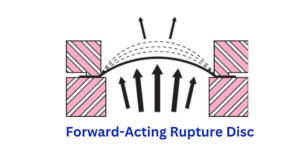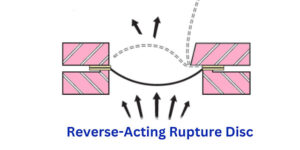Rupture disc Dsign, Types, Uses, Advantage, Disadvantage
Rupture disc is a Pressure reliving device.
A Rupture Disc is also known as a pressure safety disc, burst disc, bursting disc, or burst diaphragm is a pressure relief device that is designed to burst at a predetermined pressure and temperature. It is typically made of a thin metal disc that is clamped in a holder. When the pressure in the system exceeds the burst pressure of the disc, the disc ruptures and releases the pressure.
A rupture disc is a non-re-closing pressure relief device that protects a pressure vessel, equipment or process piping system from over-pressurization or potentially damaging vacuum conditions.
RD are, next to pressure safety valves, the most commonly used pressure protection devices in industrial plants.
A rupture disc has a one-time-use membrane that fails at a predetermined differential pressure, either positive or vacuum.
RD provide instant response to over- pressurization or under-pressurization in process piping system, but once the disc has ruptured it will not reseal.
Rupture Disc Design
RD are either round or square in shape with single or multiple layers and are either flat or domed.
Domed rupture discs can be of two shapes.
- Dome towards the process (reverse-acting rupture disc)
- Dome away from the process (forward-acting rupture discs)
Various MOC are Inconel, Hastelloy, or Tantalum, and goes all the way up to coatings or plastic liners such as PTFE or FEP.
Rupture discs are either installed directly between flanges, or inserted into a corresponding rupture disc holder, which is then mounted between flanges.
Rupture Disc Purpose
Rupture Discs are used for different different purposes like…
- Primary Relief -Rupture disc can be used as the primary relief device in a system, providing protection against overpressure.
- Secondary Relief -Rupture disc can also be used as a secondary relief device, providing backup protection in case the primary relief device fails.
Rupture Disc types
There are two type of rupture disc :
1. Forward-Acting Rupture Disc
In forward acting rupture discs, the domed side of the disc faces away from the process system. As the process pressure increases beyond the allowable operating pressure, the rupture disc starts to grow. This growth will continue as the pressure increases until the tensile strength of the material is reached and rupture occurs. Hence this type of rupture disc is also called as Tension Type Rupture Discs.
2. Reverse-Acting Rupture Disc
Reverse acting rupture discs are installed with the domed side of the rupture disc facing the process system. As the burst pressure rating of the disc is reached, the compression loading on the rupture disc causes it to reverse and open disc by a predetermined scoring pattern. It is also called as Compression loaded type disc.
Rupture disc sizing
Rupture disc sizes range from 0.125 in (3 mm) to over 4 ft (1.2 m), depending upon the industry application.
This metal disc is usually quite thin, usually in the order of 0.002 to 0.060 inches in thickness.
Rupture Disc selection
- System are protected
- Burst pressure
- Burst temperature
- Permissible overpressure or vacuum
- Process medium
- Working pressure (operating pressure)
- Vacuum resistance
- Pulsation
- Nominal Bore
- Necessary vent area, or required flow rate
- Setting:-10% above design Pressure or 20% above operating pressure.
Read More : Glass Lined Reactor
Rupture Disc Application
- Oil& Gas
- Petrochemical
- Pharmaceuticals
- food processing
- Defense and aviation
- Chemical and medical industry
Advantage
- Rupture disc can be installed with either or multiple pressure relief devices
- protect the vessel
- Leak- tightness
- Instantaneous response time
- Minimum pressure drop
- Low cost with no moving parts, rupture disc are simple, reliable, and faster acting when compare with other pressure relief devices.
- Rupture disc are light weight when compare with other pressure relief devices.
- Minimum maintenance
- Rupture disc are used for both gas or liquid handling application.
Disadvantage
- They must be replaced after each rupture occurrence.
- The allow venting until system pressure equal downstream pressure.
- Once the rupture disc burst out, we need to replace the whole rupture disc.
- The system has to shut down after the rupture disc failure, for the replacement of the rupture disc.
- High care is required during installation, a small scratch even damages the rupture disc.
- During installation, improper bolt torque also affects the disc burst pressure.
- The allow venting until system pressure equal downstream pressure.
- Once the rupture disc burst out, we need to replace the whole rupture disc.
- The system has to shut down after the rupture disc failure, for the replacement of the rupture disc.
- High care is required during installation, a small scratch even damages the rupture disc.
- During installation, improper bolt torque also affects the disc burst pressure.


